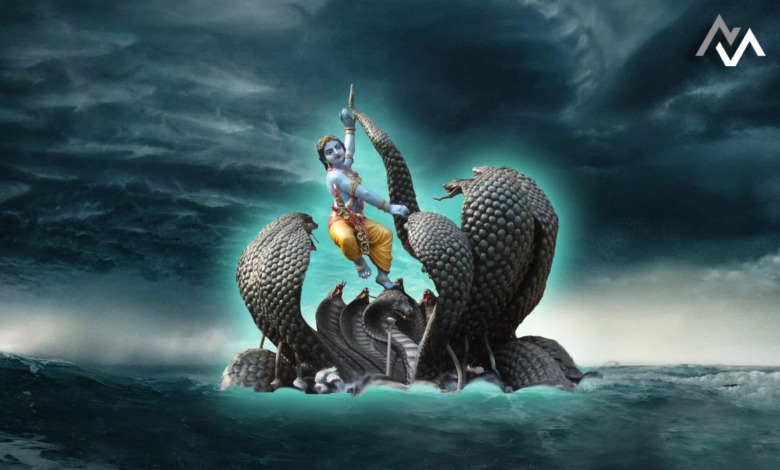Krishna Victory Over Kaliya: A Tale of Bravery and Leadership

The story of Krishna subduing the serpent Kaliya is one of the most famous episodes from Hindu mythology, highlighting themes of bravery, leadership, and divine intervention. This tale is not just a story of a miraculous victory over a fearsome adversary but also a lesson in wisdom, courage, and the qualities of an exemplary leader.
The Context: The Yamuna’s Plight
In ancient Vrindavan, the Yamuna River was the lifeblood of the community, providing water, fish, and a place for people to gather. However, the serene beauty of the Yamuna was marred by the presence of a monstrous serpent named Kaliya. Kaliya lived in the depths of the river, and his poisonous presence had turned the water dark and toxic, killing fish, plants, and making the water unfit for drinking or use. The people of Vrindavan lived in fear, knowing that this venomous creature could strike at any time.
The villagers’ despair grew as they saw the river, their primary source of sustenance, being ruined. This was the dire situation when young Krishna, still a boy, decided to intervene. His decision to face Kaliya was not just an act of courage but a testament to his deep sense of responsibility and leadership.
Krishna’s Courageous Confrontation
Krishna’s bravery was evident from the start. Despite being warned of the dangers and the powerful venom of Kaliya, he chose to act decisively. One day, Krishna climbed a tall Kadamba tree near the riverbank and leaped into the poisonous waters of the Yamuna, splashing playfully and provocatively to draw Kaliya out from the depths.
The appearance of Kaliya was terrifying: a multi-headed serpent with eyes burning like fire, hissing and spitting venom. As the serpent wrapped his coils around Krishna, the villagers who had gathered on the banks cried out in fear, believing that their beloved Krishna might be lost. But Krishna remained calm, demonstrating the first quality of an effective leader—composure in the face of danger. His calmness reassured his friends and family, showing that true leadership involves maintaining peace and confidence even when circumstances appear grim.
The Dance of Victory: Symbol of Mastery and Leadership
Krishna’s battle with Kaliya was not just a physical confrontation but also a symbolic demonstration of mastery and leadership. As Kaliya tightened his grip around Krishna, Krishna expanded his body, forcing Kaliya to loosen his coils. Then, with a swift movement, Krishna climbed onto the serpent’s hoods and began to dance.
This dance, known as the Kaliya Mardana, was a display of Krishna’s supreme confidence and skill. Each step on Kaliya’s heads was deliberate, precise, and powerful, pushing the serpent further into submission. The dance was not just an act of physical superiority; it was a clear message of Krishna’s leadership abilities—his ability to remain poised under pressure, his strategic thinking in finding Kaliya’s weakness, and his determination to protect his people at all costs.
Krishna’s dance also served as a metaphor for his ability to control and balance destructive forces. He didn’t kill Kaliya outright but instead subdued him, showing mercy and giving the serpent a chance to repent and change. This act highlighted another critical aspect of leadership—the balance between strength and compassion. By sparing Kaliya’s life and ordering him to leave the Yamuna forever, Krishna demonstrated that true power is not just about conquering enemies but also about guiding them toward a better path.
Leadership Lessons from the Kaliya Episode
- Courage and Initiative: Krishna’s decision to confront Kaliya shows the importance of taking initiative in the face of adversity. Great leaders are not afraid to step into difficult situations, even when the odds seem against them. Krishna’s bravery inspired those around him, reinforcing the idea that leadership often involves stepping into the unknown with courage and faith.
- Calmness Under Pressure: Throughout the episode, Krishna maintains his composure, never succumbing to fear or panic. This quality is essential for leaders, as it reassures and stabilizes those who look up to them during crises.
- Strategic Thinking and Skill: Krishna’s method of subduing Kaliya—by finding a way to exhaust the serpent and then dancing on his heads—demonstrates strategic thinking. Effective leaders use their skills creatively and strategically to overcome challenges.
- Compassion and Mercy: Despite his victory, Krishna chose to spare Kaliya, showing mercy and giving him a chance to change. This act teaches that true leadership is not about ruthless domination but about guiding others toward redemption and betterment. Compassion in leadership fosters loyalty and respect.
- Protecting the Greater Good: Krishna’s primary motivation was the well-being of his community. A great leader prioritizes the needs of their people and works selflessly to ensure their safety and prosperity.
Conclusion
The episode of Krishna and Kaliya is a powerful narrative filled with rich symbolism and profound lessons in leadership. It serves as a reminder that effective leaders are not just warriors who fight for victory but also wise guides who lead with courage, strategic thinking, and a deep sense of responsibility for the well-being of others. Krishna’s actions in subduing Kaliya embody the virtues of bravery, compassion, and wisdom—qualities that are timeless markers of true leadership.




